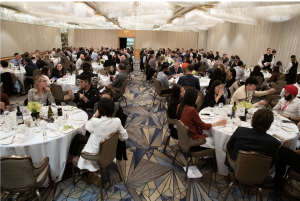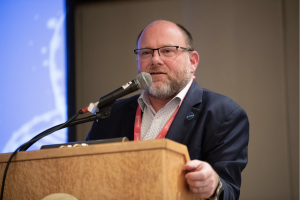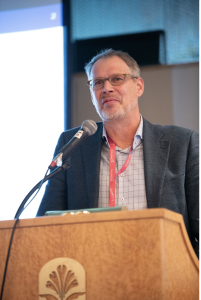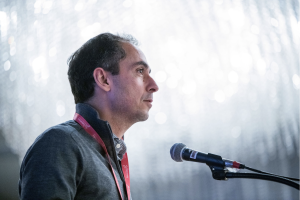Dr. Leili Rohani is a Stem Cell Scientist at the Centre for Heart Lung Innovation (HLI), St. Paul’s Hospital, and a cross-appointed Postdoctoral Fellow at the School of Biomedical Engineering, Department of Medicine, at the University of British Columbia. Leili’s research has been focused on stem cells, regenerative medicine, cell therapy, and cell-fate engineering with the intent to provide a platform for future gene and precision therapies for heart diseases. She is passionate about combining tissue engineering, single-nuclei RNA sequencing and synthetic biology tools to create a human single cell atlas of heart disease as a basis for understanding, diagnosing, monitoring and treating heart diseases. Her end goal is to look at the SynBio platform (tissue engineering, single nuclei RNAseq, synthetic biology) as a new vocabulary for disease studies to determine the ways in which cells and disease genes act, which cells are disrupted in disease, which programs change in them, what mechanisms underlie their (dis)regulation, how their cell-cell communications are affected, and what would be the impact of therapies. Beyond her research, she is passionate about science communication, networking, and collaboration. Find her on Twitter @Leili_Rohani.
Dr. Stephanie Willerth is a Full Professor and Canada Research Chair in Biomedical Engineering at the University of Victoria. She is also the CEO of Axolotl Biosciences – a biotech start-up selling reagents for 3D bioprinting human tissue models. Find her on Twitter @DrWillerth.
Can my cells be smart enough to decide how to stop disease in my body? From what I heard at The Future of Regenerative Medicine, A Speaker Event and Dinner, hosted by Creative Destruction Lab (CDL) and CCRM, it sounds like the next generation of synthetic smart cells – artificial cells that can communicate with other cells within the body to battle diseases – are on the horizon. On October 25, 2022, at the Pan Pacific Hotel in Vancouver, British Columbia, biotech scientists, mentors and ventures from across Canada, the U.S., Switzerland and the U.K. came together to discuss the future of regenerative medicine.
Here is a brief recap of the three stellar keynote talks at the event, which, incidentally, served as the kickoff for the recently launched global Advanced Therapies stream, a partnership between CDL, CCRM, the University of British Columbia (UBC), the University of Oxford, the University of Toronto and the University of Wisconsin-Madison.
Beginning the session was Michael May, President and CEO of CCRM. He started his talk by defining regenerative medicine “as science, technology and engineering-based approaches to replace or regenerate human cells, tissues and organs.” He introduced the “super cell” as a promising tool and “future of medicine driver to tackle the world’s most debilitating diseases.” He then moved on to talk about significant investment deals that recently happened in the field of cell and gene therapy (despite seeing less activity in 2022), and CCRM’s contribution to the exponential rate of growth for Notch Therapeutics and BlueRock Therapeutics.
Dr. May emphasized the strong local foundations of science and innovation supporting Canadian companies: “We have all of the pieces of the puzzle here, founded around great science,” he said. “I think that Canada represents an environment where you can hit above your weight and create synergy and collaboration.” He also talked about CCRM’s subsidiary, OmniaBio Inc., a new contract development and manufacturing organization (CDMO) that will offer Canadian and international cell and gene technology developers pre-clinical to commercial-scale manufacturing in a GMP-compliant facility being built at McMaster Innovation Park in Hamilton, Ontario. OmniaBio is filling a gap in Canada for CDMO services to enable a growing domestic industry.
In keeping with the idea of the “super cell” as the next generation of cell therapy, the second talk by Peter Zandstra, UBC, CCRM and Notch Therapeutics, focused on moving toward synthetic biology tools, smart cells, and their relevant biological products as the next generation of drugs for cell and gene therapy. Dr. Zandstra also talked about implementing tools like logic gates in a cell, and applying an approach that uses synthetic gene circuits, to achieve targeted cell behaviour using programming. Concentrating on two aspects of engineering to control a cell’s behaviour – cell engineering and niche engineering – Dr. Zandstra pointed out that developing more “in silico studies” would help to predict and reduce the cost of future cell-based therapies.
The last speaker, Ali Tehrani, Venture Partner, Amplitude Ventures, co-founder of Zymeworks, shared useful work and life tips, such as “play to win; surround yourself with people smarter than you; surround yourself with people you trust; and, play to your team’s strength.” He also made a brilliant point: “Technology is driving biology in the future – where biotech will be more tech-focused rather than biology-focused.”
All three speakers highlighted the need to cultivate local ecosystems, which bring together biologists, machine learning engineers, business leaders, supply chain experts, regulatory professionals and investors to develop a future where cures in health care will be a reality.
Much of the discussion was about smart-controlling cell systems, which caused me to wonder whether we can make “super cell” systems using synthetic biology to control extreme fibrosis and cure heart disease in patients. Something to look forward to.
Guest
Latest posts by Guest (see all)
- Regenerative immunotherapy: Hope for chronic autoimmune diseases - September 16, 2025
- Canada’s regenerative revolution: Why AI is the catalyst - September 4, 2025
- Summer by Design: A launchpad for future entrepreneurs and industry scientists - August 14, 2025










Comments